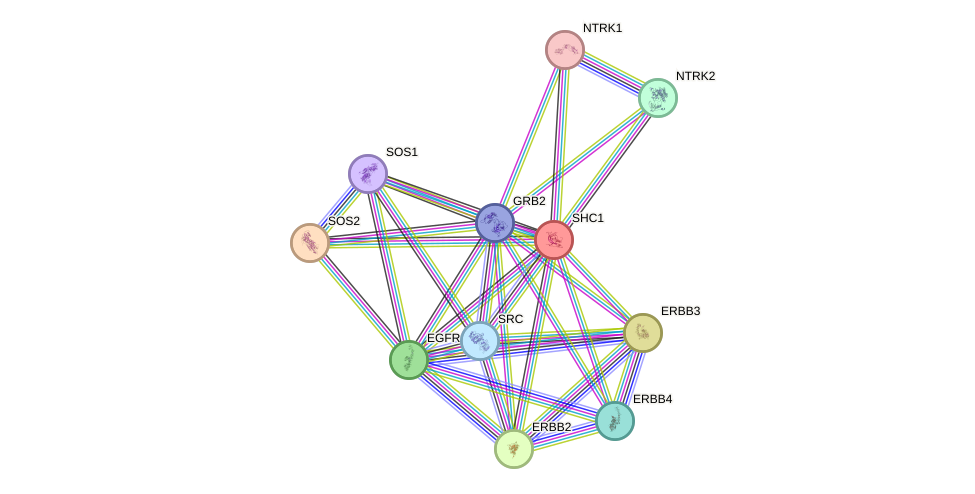GenAge entry for SHC1 (Homo sapiens)
Entry selected based on evidence directly linking the gene product to ageing in a mammalian model organism
Gene name (HAGRID: 3)
- HGNC symbol
- SHC1
- Aliases
- p66; ShcA; SHC
- Common name
- SHC (Src homology 2 domain containing) transforming protein 1
Potential relevance to the human ageing process
- Main reason for selection
- Entry selected based on evidence directly linking the gene product to ageing in a mammalian model organism
- Description
SHC1 encodes three splice variants: p46, p52, and p66. In an initial longevity study, mice double-mutants for p66 were shown to live 30% longer though it is not clear whether they age slower [6]. Additionally, the p66 mutants display an increased cognitive performance, lower emotionality and a higher pain threshold, in addition to increased basal levels of BDNF in the hippocampus, as well as decreased levels of oxidative stress markers [3626]. However, in a second study the longevity extension could not be replicated and the authors found that the knockout of Shc1 does not increase median or maximum lifespan in mice [3547]. Although the exact functions of SHC1 remain unknown, it appears to play a role in the regulation of intra-cellular redox levels, signal transduction, and apoptosis [7]. p66 mutant mice have been shown to have reduced oxidative stress and mitochondrial apoptosis. In TERC knockout mice, which normally show accelerated aging, inactivation of p66 rescues sterility and weight loss, as well as organ atrophy. However, there is no impact on shortened lifespan or telomere erosion [4354]. p66/SHC1 depletion in mice stimulates brown fat (a key thermogenic tissue) activity, resulting in a higher insulin-dependent glucose uptake and a higher energy expenditure. Additionally, brown adipose tissue cells exhibit increased mitochondrial respiration, increased expression of several mitochondrial and lipid-oxidative enzymes, which may be the cause for the improved metabolism of SHC1-deficient mice [3625]. Studies in humans have so far failed to associate polymorphisms in the SHC1 gene with ageing or longevity [231].
Cytogenetic information
- Cytogenetic band
- 1q21
- Location
- 154,962,298 bp to 154,974,483 bp
- Orientation
- Minus strand
Protein information
- Gene Ontology
-
Process: GO:0000165; MAPK cascade
GO:0000187; activation of MAPK activity
GO:0001525; angiogenesis
GO:0007173; epidermal growth factor receptor signaling pathway
GO:0007176; regulation of epidermal growth factor-activated receptor activity
GO:0007265; Ras protein signal transduction
GO:0007507; heart development
GO:0008284; positive regulation of cell proliferation
GO:0008286; insulin receptor signaling pathway
GO:0016032; viral process
GO:0016337; single organismal cell-cell adhesion
GO:0031532; actin cytoskeleton reorganization
GO:0036498; IRE1-mediated unfolded protein response
GO:0038095; Fc-epsilon receptor signaling pathway
GO:0038128; ERBB2 signaling pathway
GO:0040008; regulation of growth
GO:0043547; positive regulation of GTPase activity
GO:0045740; positive regulation of DNA replication
GO:0050900; leukocyte migration
GO:0071363; cellular response to growth factor stimulus
Cellular component: GO:0005759; mitochondrial matrix
GO:0005829; cytosol
GO:0005886; plasma membrane
GO:0070435; Shc-EGFR complex
Hide GO termsFunction: GO:0005068; transmembrane receptor protein tyrosine kinase adaptor activity
GO:0005088; Ras guanyl-nucleotide exchange factor activity
GO:0005154; epidermal growth factor receptor binding
GO:0005158; insulin receptor binding
GO:0005159; insulin-like growth factor receptor binding
GO:0005168; neurotrophin TRKA receptor binding
GO:0005515; protein binding
GO:0005543; phospholipid binding
GO:0046875; ephrin receptor binding
GO:0048408; epidermal growth factor binding
Protein interactions and network
- Protein-protein interacting partners in GenAge
- GHR, SHC1, IGF1R, STAT5B, STAT5A, GH1, NGFR, EGFR, ERBB2, INSR, IL2RG, PDGFRB, EPOR, PRKCD, RET, PLCG2, HIF1A, HSP90AA1, ABL1, PRKDC, GRB2, AIFM1, APP, PRDX1, HSPA9, HSPA1A, HSPA1B, PTK2, FLT1, PIK3R1, HSPA8, JAK2, ESR1, EPS8
- STRING interaction network
Retrieve sequences for SHC1
Homologs in model organisms
- Danio rerio
- si:dkey-246i14.4
- Mus musculus
- Shc1
- Rattus norvegicus
- Shc1
In other databases
- GenAge model organism genes
- A homolog of this gene for Mus musculus is present as Shc1
- LongevityMap
- This gene is present as SHC1

